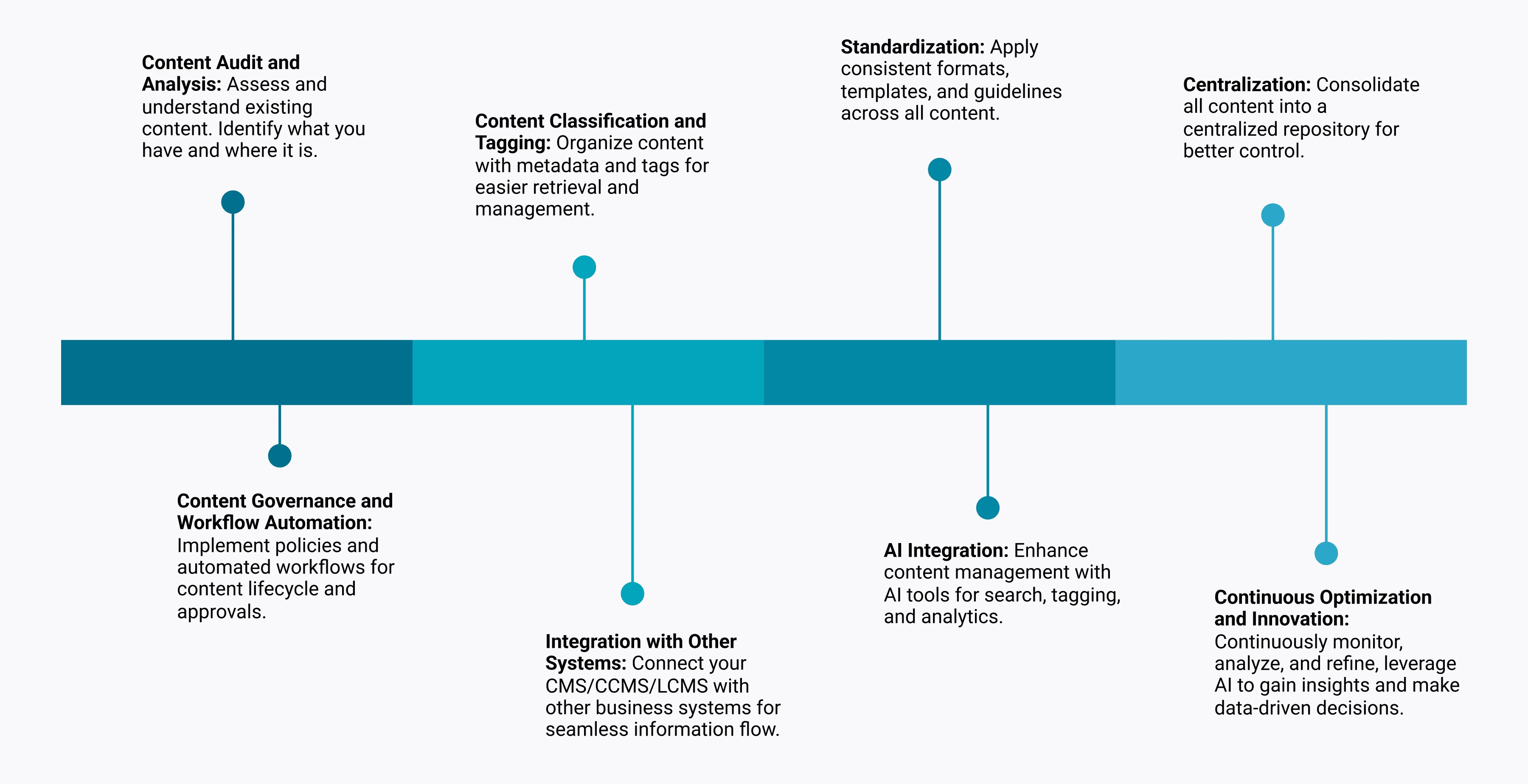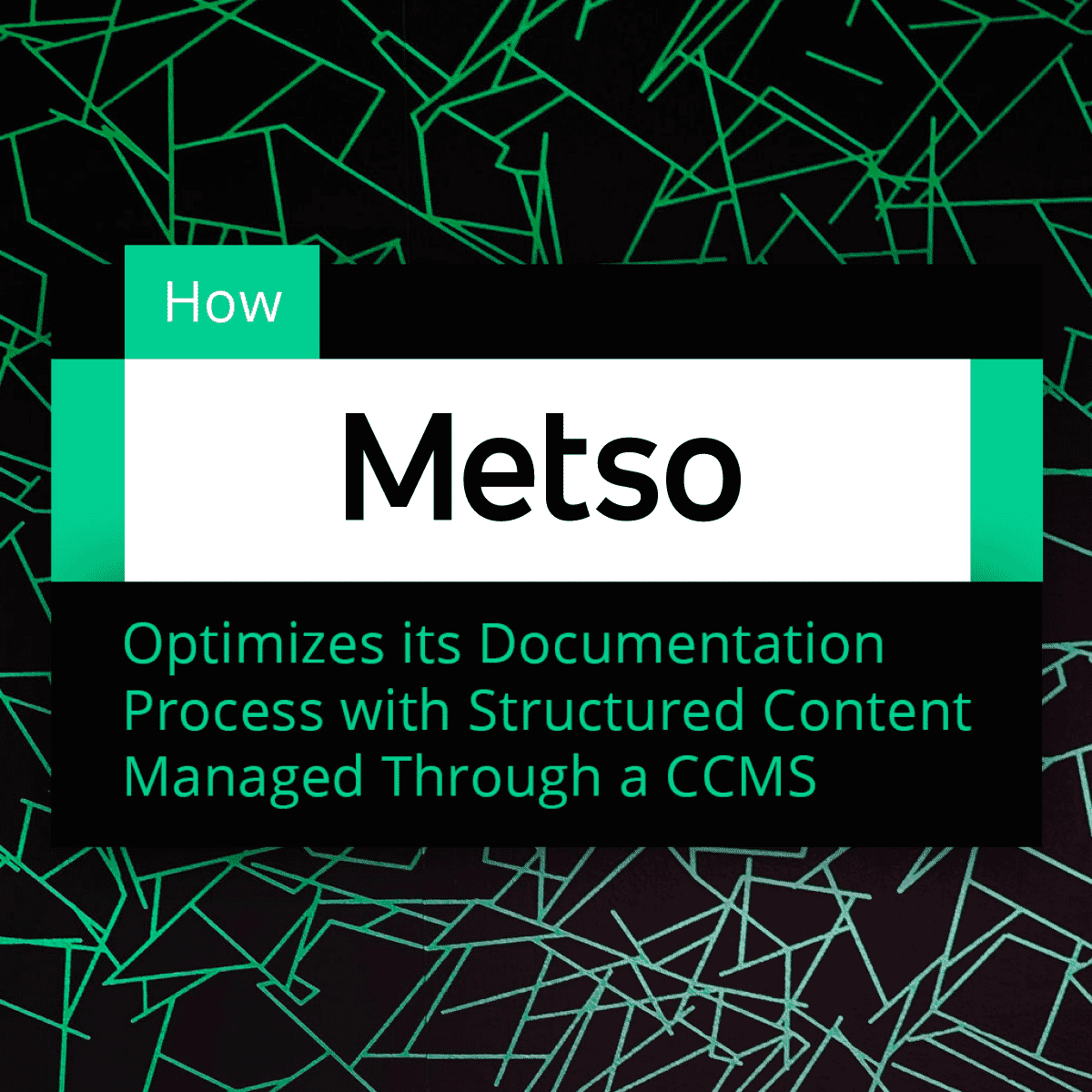Artificial Intelligence (AI) is transforming industries, with significant impacts on content management, technical documentation, and learning content. For organizations aiming to harness AI effectively, the quality and structure of their content are crucial. AI systems rely heavily on the data they process, making structured content essential.
Structured content lays the foundation for AI to build scalable, efficient solutions that drive business success.
How does structured content prepare your organization for AI?
Understanding Structured Content
What Is Structured Content?
Structured content authoring takes a systematic approach to creating and managing information. It breaks down content into smaller, reusable, and consistent components, unlike traditional content, which is often stored in lengthy, unstructured documents. This modular approach makes content easier to manage, reuse, and publish across multiple platforms.

Key Principles of Structured Content:
- Modularity: Content is divided into self-contained modules, each representing specific information like a topic, concept, or task. These modules can be reused across multiple documents without modification.
- Separation of Content and Format: Structured content separates content from its presentation, allowing writers to focus on the information while ensuring consistent formatting.
- Reusability: Structured content’s modularity allows information to be reused in different contexts, reducing duplication and ensuring consistent updates across all instances.
- Consistency: Structured authoring enforces a uniform format and style across all content, enhancing readability, comprehension, and adherence to organizational standards.
Beyond mere organization, structured content brings significant efficiency gains. Frameworks like DITA (Darwin Information Typing Architecture) categorize content into types such as concepts, tasks, and references. Understanding what DITA is helps simplify content management and repurposing across various outputs. Such an approach is especially valuable in industries requiring content delivery, such as technical documentation, regulatory compliance, and learning materials, in multiple formats and languages.
The Importance of Structured Content and Semantics
A powerful aspect of structured content is its use of semantic elements, which add layers of meaning that both humans and AI can understand. Semantics involve specific tags, metadata, and structural components that define relationships between different content pieces or add a description as to what the purpose of the element. This structure enables AI systems to retrieve information more accurately and understand the context and relationships within the content.
For instance, in a DITA framework, content is categorized into types like “task”, “concept”, and “reference” each with its own semantic meaning, and purpose. AI systems leverage these semantic distinctions to process content intelligently, powering applications like content recommendation engines, automated tagging, and advanced search functionalities.
Semantic tagging also enhances content personalization and contextualization, ensuring that users receive the most relevant information based on their specific needs. This semantic layer makes content intelligible to AI, enabling it to grasp the nuances of meaning and relationships between pieces of content.
Example from Industry Experience: A large healthcare organization struggled with managing its expanding library of technical documentation, which was scattered across different systems, in different formats. This fragmentation led to inconsistencies, inefficiencies, and compliance risks. By adopting a structured content approach using DITA, the organization harmonized its documentation, reduced redundancies, and improved compliance. They also managed to start bridging the silos between different documentation departments. By adopting DITA structured writing, in a CCMS available to all departments, the teams were better able to understand the relationships between content pieces. This enabled improved reuse mechanisms, resulting in a 30% reduction in content retrieval time and a 25% improvement in content accuracy across global teams.
In summary, structured content is not just an organizational method; it is a strategic approach that empowers organizations to manage content more effectively. This approach ensures consistency, reusability, and adaptability to various outputs and formats—qualities essential for integrating AI into content management processes.
The Synergy Between Structured Content and AI
Why Structured Content Is Essential for AI Success
AI thrives on structured data. To perform tasks like content categorization, personalization, and data analysis, AI tools require content that is not only rich in information but also well-organized and accessible. Structured content provides the necessary framework for AI to operate effectively.

Examples of AI Impact on the Content Development Lifecycle
- Reducing Go-To-Market (GTM) Time: By implementing structured content, organizations can significantly reduce their time to market. AI tools integrated with these systems can aid in reducing repetitive tasks such as tagging, categorization, and metadata management. Some content management systems have a mechanism for identifying reusable content, however, when AI identification is added to the mix, the suggestions can be more accurate. This automation frees content teams to focus on high-value activities, accelerating content creation and shortening the product launch cycle.
- Improving Efficiency in Content Creation and Management: AI-enabled content management systems streamline content workflows by automating content assembly, ensuring compliance, and enabling real-time collaboration across global teams. AI can suggest content enhancements, and ensure all content adheres to organizational style guides and regulatory requirements. This results in more efficient content creation processes, reducing errors and ensuring consistency across all outputs.
- Boosting Productivity: AI-powered tools enhance productivity by reducing the manual effort required in content creation and management. AI can analyze existing content to identify gaps, recommend improvements, and predict future content needs based on usage patterns and feedback. This proactive approach allows content teams to stay ahead, ensuring that the right content is always available to the right audience at the right time.
AI is poised to revolutionize how work is done… and content management is core to your AI strategy.
Anthony Olivier | Chief Executive Officer, MadCap Software
- Enhancing Regulatory Compliance: AI-enabled systems can be set to detect changes in external systems, such as requirements databases and risk analysis tables, and can trigger content audits. These systems offer suggestions for necessary updates and assess whether related topics should also be revised. AI could enhance the auditing process by providing trace analysis and version control matrices, showing what content changed, when, and why. AI can perform real-time analysis across vast amounts of content dispersed in different systems and be used for regression and impact analysis, providing a more comprehensive view of potential content risks and necessary updates.
Structured Content as the Backbone of AI-Powered Content Delivery
Enhancing Content Delivery with AI
Content management involves more than just storing and retrieving documents. It’s about delivering the right content to the right audience at the right time. AI plays a crucial role by automating processes such as content categorization, tagging, and recommendation.
AI’s effectiveness depends on the quality and structure of the content it processes. Structured content serves as the backbone of AI-powered content management, enabling AI tools to integrate seamlessly and function across various systems.

The Role of Semantics in Content Management and Delivery
Semantics play a vital role in enabling AI to understand and process content more effectively. By embedding semantic tags within structured content, organizations provide AI systems with the context needed to identify, retrieve, and analyze information accurately. This semantic enrichment is especially valuable in AI applications like advanced search, content recommendation engines, and natural language processing (NLP). For example, AI can automatically tag and categorize content based on predefined criteria, making it easier for users to find the information they need. Additionally, AI can curate content, personalizing delivery based on user behavior and preferences. This efficiency is achievable only when the content is well-structured, with clear metadata and consistent organization.
AI-Driven Content Creation and Assistance
Leveraging AI for Content Creation and Enhancement
AI is increasingly being used not just to manage content, but also to create and enhance it. Features included in Content Management Systems like MadCap Central’s AI Assist and AI Positron in IXIA CCMS provide advanced capabilities for content teams, enabling them to streamline workflows and improve content quality.
AI Assist, powered by OpenAI’s ChatGPT, can draft outlines, suggest content improvements, and enhance the structure of existing documents. This is particularly beneficial for large-scale content operations where consistency and accuracy are paramount. The same is true in IXIA CCMS with AI Positron, with the added advantage of being able to connect it to Anthropic Claude, Microsoft Azure and ChatGPT. Structured content plays a crucial role, as it provides AI with the context needed to generate the right response.
AI-driven content creation is not about replacing human creativity but augmenting it. By handling repetitive tasks and ensuring compliance with content standards, AI allows content creators to focus on more strategic, high-value work.
Preparing Your Organization for AI Integration
Set Up Your Content for AI Success
To take full advantage of AI's capabilities, organizations must establish a robust content infrastructure that ensures content is both accessible and optimized for AI processing.
The 3 Pillars in Preparing for AI: Content Access, Content Intelligence, and Content Assistance.
Content Access: At the core of any AI strategy is making content available to AI-powered tools. This means centralizing content into a single source of truth, such as an learning content management system software like Xyleme or a DITA-native CCMS like IXIA. These systems ensure that proprietary content is securely stored and can be accessed by AI solutions with the necessary controls, traceability, and governance. Organizing content in this way allows AI tools to retrieve and use the exact information they need, when they need it, without risking data silos or inconsistencies.
AI can connect people to the content they need when and where they need it—but only if your content is properly managed and readily accessible.
Leslie Farinella | Former Chief Strategy Officer, Xyleme
Content Intelligence:
Empower your content teams with AI-driven insights. By leveraging AI, teams can navigate, group, and understand content more effectively, leading to more informed, hyper efficient content strategy decisions. AI can assist in tagging and categorizing content, making it easier to search and ensuring users find the most relevant information. This is crucial in fast-paced environments, where quickly adapting content to meet changing demands can provide a significant competitive advantage. As noted in the webinar, “Structured content and standardized interaction data are both a solid foundation and high-octane fuel for AI.”
Content Assistance: Finally, AI can play a transformative role in content creation and enhancement. Tools like MadCap Central’s AI Assist and AI Positron in IXIA CCMS offer intelligent assistance throughout the content development lifecycle. These tools can draft outlines, suggest improvements, enhance content structure, and ensure compliance with style guides and regulations. This streamlines the authoring process and reduces the risk of human error. By integrating AI into content workflows, organizations can significantly increase efficiency and allow teams to focus on high-value tasks.
AI generation has the potential to make authoring content more efficient—improving your work life.
Paul Stoecklein | Documentation Director, MadCap Software
Practical Steps for AI Integration

- Centralize Your Content: Begin by consolidating all content into a single, secure repository. This could be an LCMS like Xyleme, which excels in handling structured content for learning, IXIA CCMS, which is a DITA-native CCMS designed for technical documentation, or MadCap Central.
- Standardize and Structure: Ensure content is consistently structured and tagged with metadata. This makes it easier for AI to process and understand content, leading to more accurate and relevant outputs.
- Leverage AI Tools: Utilize AI tools to assist with content creation, enhancement, and management. Implement features like automated tagging, content suggestion, and compliance checks to streamline workflows.
- Prepare for Continuous Improvement: AI-driven content management is not a one-time setup. Continuously monitor and refine content strategies based on AI insights to keep up with evolving business needs and technological advancements.
Incorporating these strategies will prepare your content for AI and position your organization to fully capitalize on the efficiencies and innovations that AI can bring.
Conclusion
With the introduction of AI-powered solutions to the arena of content management, structured content is not just a competitive advantage; it is a necessity. By organizing and managing your content effectively, you set the stage for AI to deliver its full potential, driving efficiency, accuracy, and innovation across your organization.
MadCap Software is committed to empowering your AI strategy with tools that make content accessible, intelligent, and actionable.
Visit the MadCap AI Portal to learn more about how you can prepare your organization for AI success and unlock the full potential of your content.










